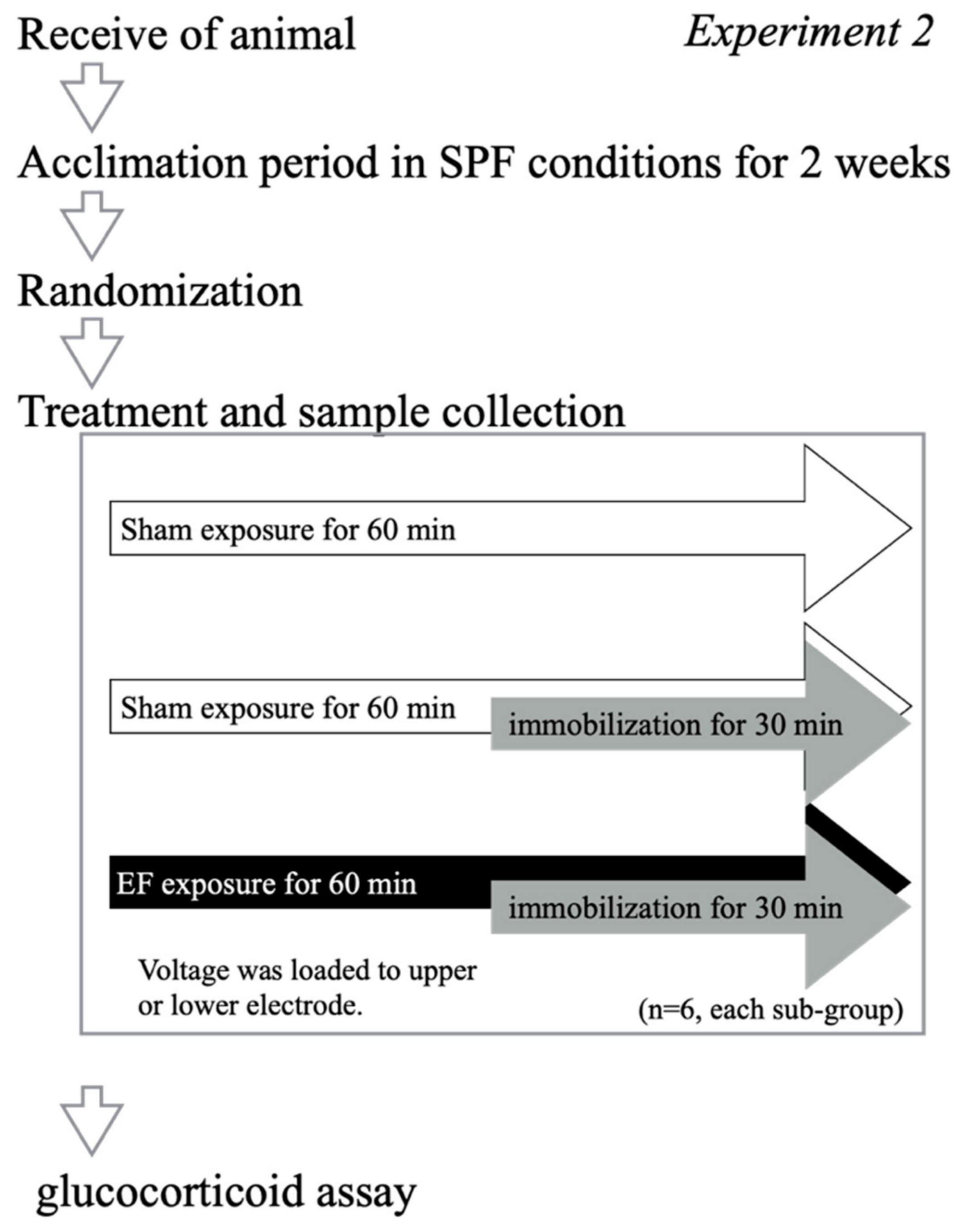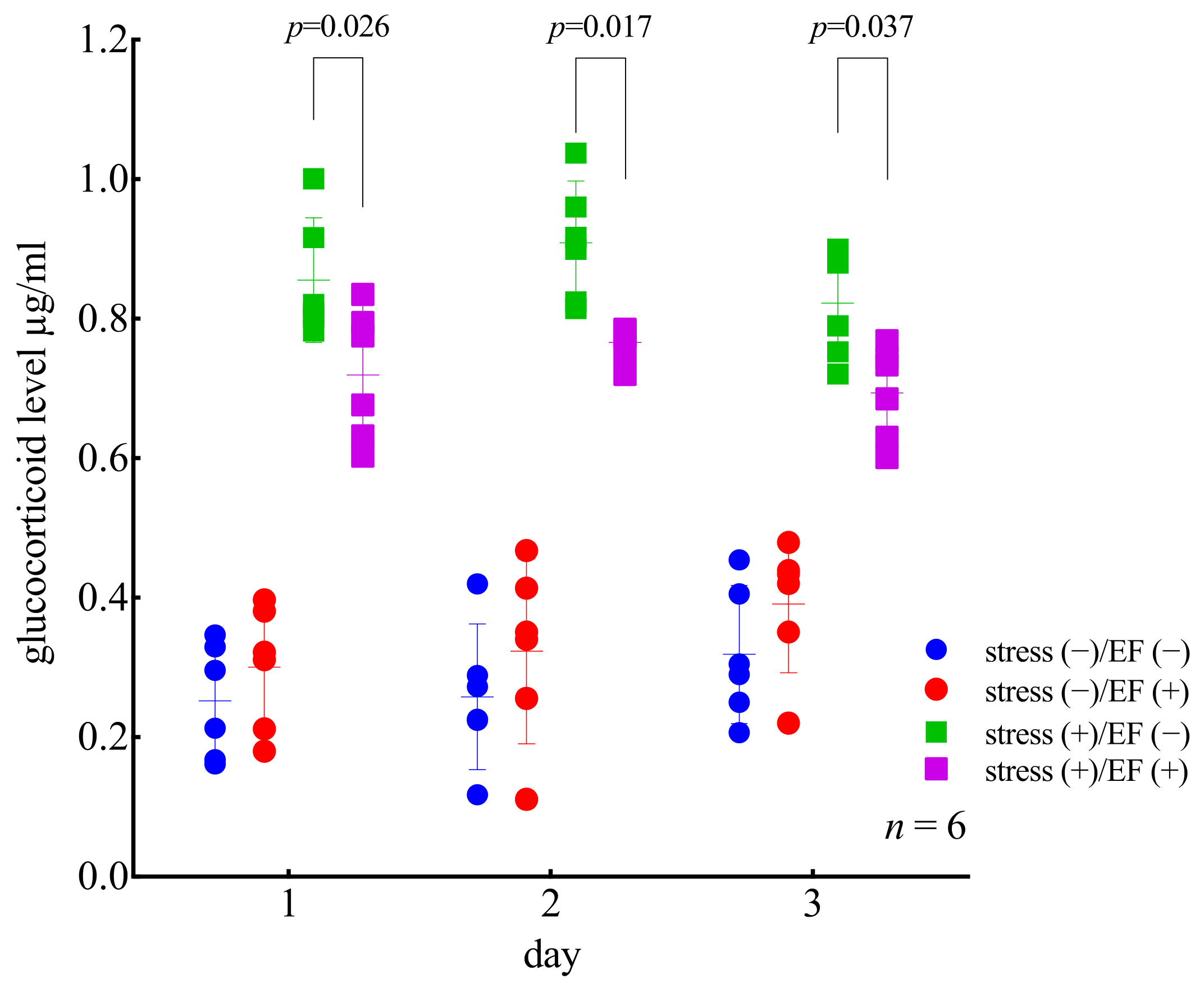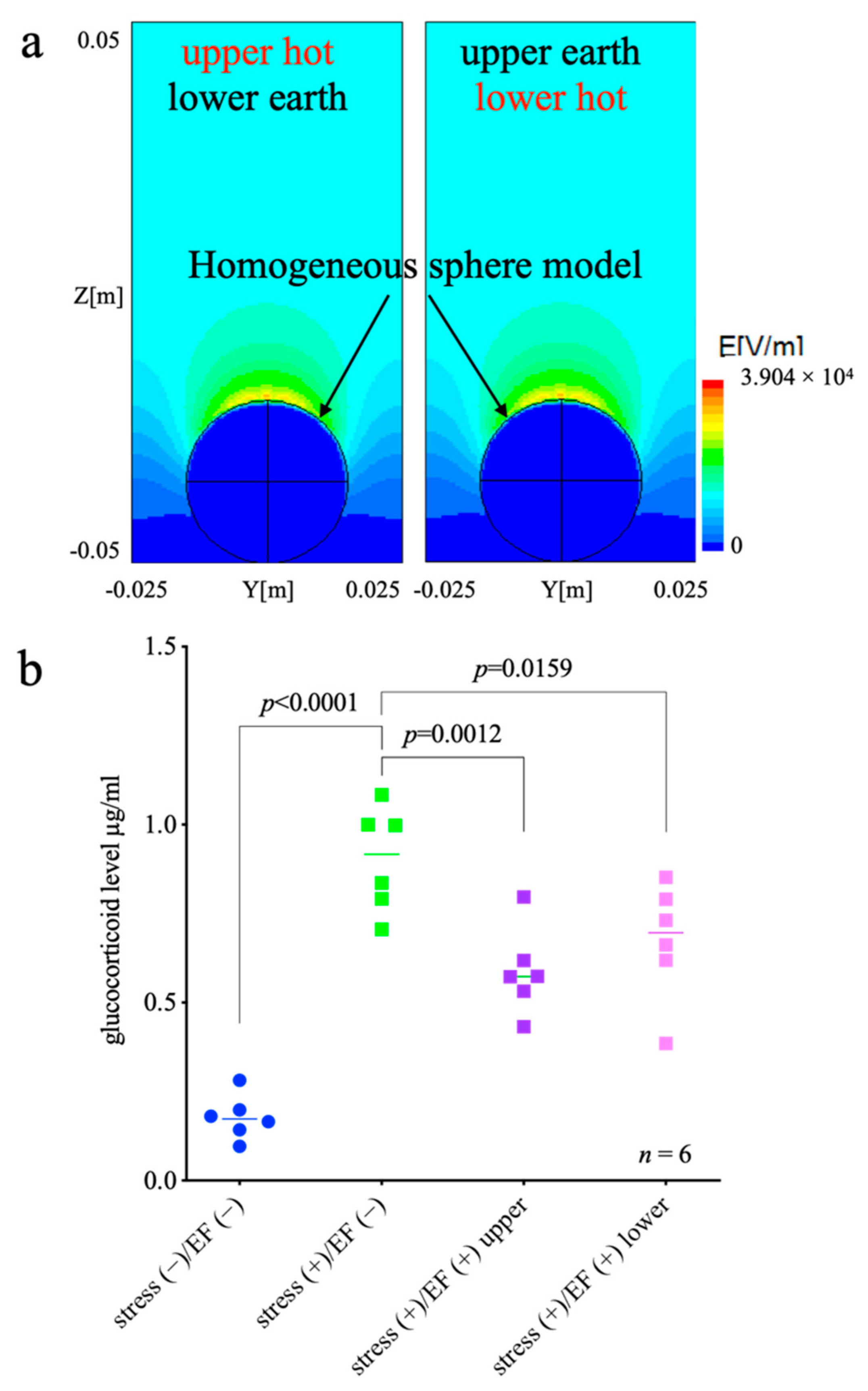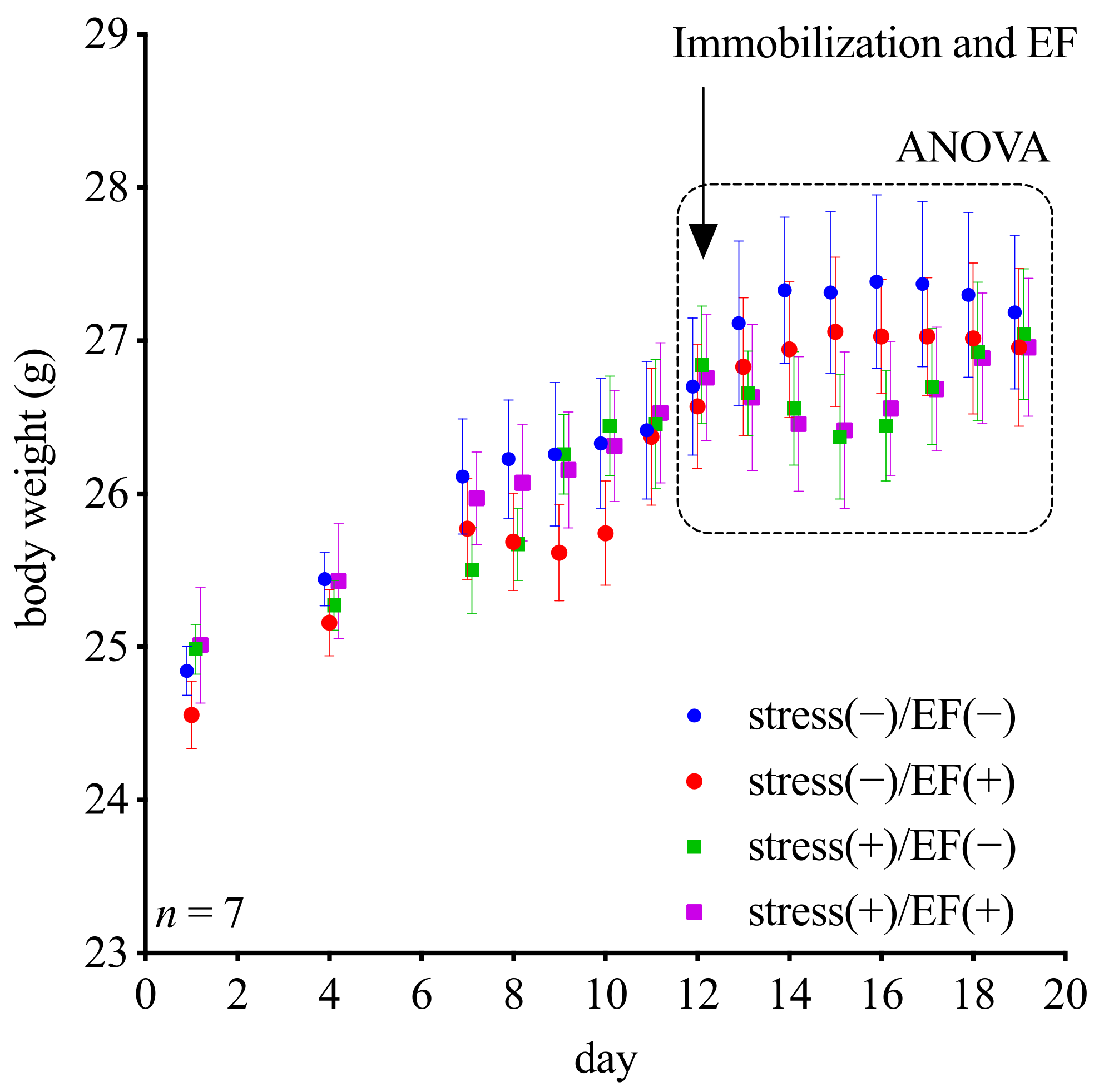Stress-Reducing Effect of a 50 Hz Electric Field in Mice after Repeated Immobilizations, Electric Field Shields, and Polarization of the Electrodes
Abstract
Simple Summary
Abstract
1. Introduction
2. Materials and Methods
2.1. Animals
2.2. EF Exposure System
2.3. Immobilization Stress
2.4. Experiment 1: Effect of EF on Plasma Glucocorticoid Levels in Repeatedly Immobilized Mice
2.5. Experiment 2: Effect of the Polarization of the Electrode on the Suppressive Effect of EF
2.6. Experiment 3: Effect of EF Shield on the Suppressive Effect of EF
2.7. Plasma Glucocorticoid Level
2.8. Experiment 4: Change in Bodyweight
2.9. Statistical Analysis
3. Results
3.1. Experiment 1: Effect of EF on Plasma Glucocorticoid Levels in Repeatedly Immobilized Mice
3.2. Experiment 2: Effect of the Polarization of the Electrode on the Suppressive Effect of EF
3.3. Experiment 3: Effect of EF Shield on the Suppressive Effect of EF
3.4. Experiment 4: Change in Bodyweight
4. Discussion
5. Conclusions
Author Contributions
Funding
Institutional Review Board Statement
Informed Consent Statement
Data Availability Statement
Acknowledgments
Conflicts of Interest
References
- International Commission on Non-Ionizing Radiation Protection ICNIRP. Gaps in Knowledge Relevant to the “Guidelines for Limiting Exposure to Time-Varying Electric and Magnetic Fields (1 Hz–100 kHz)”. Health Phys. 2020, 118, 533–542. [Google Scholar] [CrossRef] [PubMed]
- International Commission on Non-Ionizing Radiation Protection ICNIRP. Principles for Non-Ionizing Radiation Protection. Health Phys. 2020, 118, 477–482. [Google Scholar] [CrossRef] [PubMed]
- International Commission on Non-Ionizing Radiation Protection ICNIRP. Guidelines for limiting exposure to time-varying electric and magnetic fields (1 Hz to 100 kHz). Health Phys. 2010, 99, 818–836. [Google Scholar] [CrossRef] [PubMed]
- World-Health-Organization WHO. Extremely Low Frequency Fields Environmental Health Criteria Monograph No. 238. 2007. Available online: https://www.who.int/publications/i/item/9789241572385 (accessed on 14 February 2022).
- Mitani, Y.; Matsugi, A.; Okano, H.; Nedachi, T.; Hara, H. Effect of exposure to a high-voltage alternating current electric field on muscle extensibility. J. Jpn. Soc. Balneol. Climatol. Phys. Med. 2015, 78, 244–252. [Google Scholar]
- Mattsson, M.O.; Simkó, M. Emerging medical applications based on non-ionizing electromagnetic fields from 0 Hz to 10 THz. Med. Devices 2019, 12, 347–368. [Google Scholar] [CrossRef]
- Ohtsuki, T.; Nabeta, T.; Nakanishi, H.; Kawahata, H.; Ogihara, T.; Morishita, R.; Aoki, M. Electric Field Exposure Improves Subjective Symptoms Related to Sleeplessness in College Students: A Pilot Study of Electric Field Therapy for Sleep Disorder. Immunol. Endocr. Metab. Agents Med. Chem. 2017, 17, 37–48. [Google Scholar] [CrossRef][Green Version]
- Shinba, T.; Takahashi, K.; Kanetake, S.; Nedachi, T.; Yamaneki, M.; Doge, F.; Hori, T.; Harakawa, S.; Miki, M.; Hara, H.; et al. A pilot study on electric field therapy for chronic pain with no obvious underlying diseases. Jpn. Soc. Integr. Med. 2012, 5, 68–72. [Google Scholar]
- Ito, F.; Ohsaki, K.; Takahashi, K.; Hara, H. The Effects of Electric Field Therapeutic Device (Healthtron) on the Stiffness in the Neck and Shoulder Area: Changes in subjective symptoms, blood circulation and the autonomic nervous system. J. Jpn. Soc. Balneol. Climatol. Phys. Med. 2005, 68, 110–121. [Google Scholar] [CrossRef]
- Coskun, O.; Comlekci, S. Effect of ELF electric field on some on biochemistry characters in the rat serum. Toxicol. Ind. Health 2011, 27, 329–333. [Google Scholar] [CrossRef]
- Akpinar, D.; Ozturk, N.; Ozen, S.; Agar, A.; Yargicoglu, P. The effect of different strengths of extremely low-frequency electric fields on antioxidant status, lipid peroxidation, and visual evoked potentials. Electromagn. Biol. Med. 2012, 31, 436–448. [Google Scholar] [CrossRef]
- Di, G.; Gu, X.; Lin, Q.; Wu, S.; Kim, H.B. A comparative study on effects of static electric field and power frequency electric field on hematology in mice. Ecotoxicol. Environ. Saf. 2018, 166, 109–115. [Google Scholar] [CrossRef]
- Gok, D.K.; Akpinar, D.; Hidisoglu, E.; Ozen, S.; Agar, A.; Yargicoglu, P. The developmental effects of extremely low frequency electric fields on visual and somatosensory evoked potentials in adult rats. Electromagn. Biol. Med. 2016, 35, 65–74. [Google Scholar] [CrossRef] [PubMed]
- Weigel, R.J.; Jaffe, R.A.; Lundstrom, D.L.; Forsythe, W.C.; Anderson, L.E. Stimulation of cutaneous mechanoreceptors by 60-Hz electric fields. Bioelectromagnetics 1987, 8, 337–350. [Google Scholar] [CrossRef]
- Weigel, R.J.; Lundstrom, D.L. Effect of relative humidity on the movement of rat vibrissae in a 60-Hz electric field. Bioelectromagnetics 1987, 8, 107–110. [Google Scholar] [CrossRef] [PubMed]
- Romo, R.; Hernandez, A.; Zainos, A.; Brody, C.; Salinas, E. Exploring the cortical evidence of a sensory-discrimination process. Philos. Trans. R. Soc. Lond. B Biol. Sci. 2002, 357, 1039–1051. [Google Scholar] [CrossRef][Green Version]
- Romo, R.; Hernandez, A.; Zainos, A.; Brody, C.D.; Lemus, L. Sensing without touching: Psychophysical performance based on cortical microstimulation. Neuron 2000, 26, 273–278. [Google Scholar] [CrossRef]
- Romo, R.; Hernandez, A.; Zainos, A.; Salinas, E. Somatosensory discrimination based on cortical microstimulation. Nature 1998, 392, 387–390. [Google Scholar] [CrossRef] [PubMed]
- Kato, M.; Ohta, S.; Shimizu, K.; Tsuchida, Y.; Matsumoto, G. Detection-threshold of 50-Hz electric fields by human subjects. Bioelectromagnetics 1989, 10, 319–327. [Google Scholar] [CrossRef]
- Reilly, J.P. Neuroelectric mechanisms applied to low frequency electric and magnetic field exposure guidelines—Part I: Sinusoidal waveforms. Health Phys. 2002, 83, 341–355. [Google Scholar] [CrossRef]
- Harakawa, S.; Hori, T.; Inoue, N.; Okano, H.; Nedachi, T.; Suzuki, H. Effect of extensive electric field therapy in bone density. Jpn. Soc. Integr. Med. 2014, 7, 60–66. [Google Scholar]
- Harakawa, S.; Nedachi, T.; Suzuki, H. Extremely low-frequency electric field suppresses not only induced stress response but also stress-related tissue damage in mice. Sci. Rep. 2020, 10, 20930. [Google Scholar] [CrossRef] [PubMed]
- Takahashi, K.; Doge, F.; Yoshioka, M. Prolonged Ca2+ transients in ATP-stimulated endothelial cells exposed to 50 Hz electric fields. Cell Biol. Int. 2005, 29, 237–243. [Google Scholar] [CrossRef] [PubMed]
- Takahashi, K.; Kuroki, M.; Doge, F.; Sawasaki, Y.; Yoshioka, M. Effects of low-frequency electric fields on the intracellular Ca2+ response induced in human vascular endothelial cells by vasoactive substances. Electromagn. Biol. Med. 2002, 21, 279–286. [Google Scholar] [CrossRef]
- Marino, A.A.; Kolomytkin, O.V.; Frilot, C. Extracellular currents alter gap junction intercellular communication in synovial fibroblasts. Bioelectromagnetics 2003, 24, 199–205. [Google Scholar] [CrossRef] [PubMed]
- Kolomytkin, O.V.; Dunn, S.; Hart, F.X.; Frilot, C.; Kolomytkin, D.; Marino, A.A. Glycoproteins bound to ion channels mediate detection of electric fields: A proposed mechanism and supporting evidence. Bioelectromagnetics 2007, 28, 379–385. [Google Scholar] [CrossRef]
- Yanamoto, H.; Miyamoto, S.; Nakajo, Y.; Nakano, Y.; Hori, T.; Naritomi, H.; Kikuchi, H. Repeated application of an electric field increases BDNF in the brain, enhances spatial learning, and induces infarct tolerance. Brain Res. 2008, 1212, 79–88. [Google Scholar] [CrossRef]
- Kariya, T.; Hori, T.; Harakawa, S.; Inoue, N.; Nagasawa, H. Exposure to 50-Hz electric fields on stress response initiated by infection with the protozoan parasite, Toxoplasma gondii, in mice. J. Protozool. Res. 2006, 16, 51–59. [Google Scholar]
- Hori, T.; Yamsaard, T.; Ueta, Y.Y.; Harakawa, S.; Kaneko, E.; Miyamoto, A.; Xuan, X.; Toyoda, Y.; Suzuki, H. Exposure of C57BL/6J male mice to an electric field improves copulation rates with superovulated females. J. Reprod. Dev. 2005, 51, 393–397. [Google Scholar] [CrossRef]
- Imaki, T.; Nahan, J.L.; Rivier, C.; Sawchenko, P.E.; Vale, W. Differential regulation of corticotropin-releasing factor mRNA in rat brain regions by glucocorticoids and stress. J. Neurosci. 1991, 11, 585–599. [Google Scholar] [CrossRef] [PubMed]
- Selye, H. The general adaptation syndrome and the diseases of adaptation. J. Clin. Endocrinol. Metab. 1946, 6, 117–230. [Google Scholar] [CrossRef] [PubMed]
- Nicolaides, N.C.; Kyratzi, E.; Lamprokostopoulou, A.; Chrousos, G.P.; Charmandari, E. Stress, the stress system and the role of glucocorticoids. Neuroimmunomodulation 2015, 22, 6–19. [Google Scholar] [CrossRef] [PubMed]
- Hori, T.; Inoue, N.; Suzuki, H.; Harakawa, S. Exposure to 50 Hz electric fields reduces stress-induced glucocorticoid levels in BALB/c mice in a kV/m- and duration-dependent manner. Bioelectromagnetics 2015, 36, 302–308. [Google Scholar] [CrossRef] [PubMed]
- Hori, T.; Inoue, N.; Suzuki, H.; Harakawa, S. Configuration-dependent variability of the effect of an electric field on the plasma glucocorticoid level in immobilized mice. Bioelectromagnetics 2017, 38, 265–271. [Google Scholar] [CrossRef] [PubMed]
- Hori, T.; Nedachi, T.; Suzuki, H.; Harakawa, S. Characterization of the suppressive effects of extremely-low-frequency electric fields on a stress-induced increase in the plasma glucocorticoid level in mice. Bioelectromagnetics 2018, 39, 516–528. [Google Scholar] [CrossRef] [PubMed]
- Harakawa, S.; Hori, T.; Nedachi, T.; Suzuki, H. Gender and Age Differences in the Suppressive Effect of a 50 Hz Electric Field on the Immobilization-Induced Increase of Plasma Glucocorticoid in Mice. Bioelectromagnetics 2020, 41, 156–163. [Google Scholar] [CrossRef] [PubMed]
- Kirby, E.D.; Geraghty, A.C.; Ubuka, T.; Bentley, G.E.; Kaufer, D. Stress increases putative gonadotropin inhibitory hormone and decreases luteinizing hormone in male rats. Proc. Natl. Acad. Sci. USA 2009, 106, 11324–11329. [Google Scholar] [CrossRef]
- Bahlouli, W.; Breton, J.; Lelouard, M.; L’Huillier, C.; Tirelle, P.; Salameh, E.; Amamou, A.; Atmani, K.; Goichon, A.; Bôle-Feysot, C.; et al. Stress-induced intestinal barrier dysfunction is exacerbated during diet-induced obesity. J. Nutr. Biochem. 2020, 81, 108382. [Google Scholar] [CrossRef]
- Lu, X.T.; Liu, Y.F.; Zhao, L.; Li, W.J.; Yang, R.X.; Yan, F.F.; Zhao, Y.X.; Jiang, F. Chronic psychological stress induces vascular inflammation in rabbits. Stress 2013, 16, 87–98. [Google Scholar] [CrossRef]
- Silverman, M.N.; Sternberg, E.M. Glucocorticoid regulation of inflammation and its functional correlates: From HPA axis to glucocorticoid receptor dysfunction. Ann. N. Y. Acad. Sci. 2012, 1261, 55–63. [Google Scholar] [CrossRef]
- Hayley, S.; Kelly, O.; Anisman, H. Corticosterone changes in response to stressors, acute and protracted actions of tumor necrosis factor-alpha, and lipopolysaccharide treatments in mice lacking the tumor necrosis factor-alpha p55 receptor gene. Neuroimmunomodulation 2004, 11, 241–246. [Google Scholar] [CrossRef]
- Brattsand, R.; Linden, M. Cytokine modulation by glucocorticoids: Mechanisms and actions in cellular studies. Aliment. Pharmacol. Ther. 1996, 10, 81–90; discussion 91. [Google Scholar] [CrossRef]
- Chrousos, G.P. Stress and disorders of the stress system. Nat. Rev. Endocrinol. 2009, 5, 374–381. [Google Scholar] [CrossRef]
- Shi, S.S.; Shao, S.H.; Yuan, B.P.; Pan, F.; Li, Z.L. Acute stress and chronic stress change brain-derived neurotrophic factor (BDNF) and tyrosine kinase-coupled receptor (TrkB) expression in both young and aged rat hippocampus. Yonsei Med. J. 2010, 51, 661–671. [Google Scholar] [CrossRef] [PubMed]
- Givalois, L.; Marmigere, F.; Rage, F.; Ixart, G.; Arancibia, S.; Tapia-Arancibia, L. Immobilization stress rapidly and differentially modulates BDNF and TrkB mRNA expression in the pituitary gland of adult male rats. Neuroendocrinology 2001, 74, 148–159. [Google Scholar] [CrossRef] [PubMed]
- Zenker, N.; Bernstein, D.E. The estimation of small amounts of corticosterone in rat plasma. J. Biol. Chem. 1958, 231, 695–701. [Google Scholar] [CrossRef]
- Kvetnansky, R.; Weise, V.K.; Thoa, N.B.; Kopin, I.J. Effects of chronic guanethidine treatment and adrenal medullectomy on plasma levels of catecholamines and corticosterone in forcibly immobilized rats. J. Pharmacol. Exp. Ther. 1979, 209, 287–291. [Google Scholar] [PubMed]
- Njung’e, K.; Handley, S.L. Evaluation of marble-burying behavior as a model of anxiety. Pharmacol. Biochem. Behav. 1991, 38, 63–67. [Google Scholar] [CrossRef]
- Kawasaki, H.; Okano, H.; Nedachi, T.; Nakagawa-Yagi, Y.; Hara, A.; Ishida, N. Effects of an electric field on sleep quality and life span mediated by ultraviolet (UV)-A/blue light photoreceptor CRYPTOCHROME in Drosophila. Sci. Rep. 2021, 11, 20543. [Google Scholar] [CrossRef]
- Hara, A.; Hara, H.; Suzuki, N.; Harakawa, S.; Uenaka, N.; Martin, D.; Harris, H.; Inventor; Hakuju Institute for Health Science Inc. Assignee. Methods of Treating Disorders with Electric Fields. U.S. Patent Application No US20050187581A1, 25 August 2005. [Google Scholar]








Publisher’s Note: MDPI stays neutral with regard to jurisdictional claims in published maps and institutional affiliations. |
© 2022 by the authors. Licensee MDPI, Basel, Switzerland. This article is an open access article distributed under the terms and conditions of the Creative Commons Attribution (CC BY) license (https://creativecommons.org/licenses/by/4.0/).
Share and Cite
Harakawa, S.; Nedachi, T.; Shinba, T.; Suzuki, H. Stress-Reducing Effect of a 50 Hz Electric Field in Mice after Repeated Immobilizations, Electric Field Shields, and Polarization of the Electrodes. Biology 2022, 11, 323. https://doi.org/10.3390/biology11020323
Harakawa S, Nedachi T, Shinba T, Suzuki H. Stress-Reducing Effect of a 50 Hz Electric Field in Mice after Repeated Immobilizations, Electric Field Shields, and Polarization of the Electrodes. Biology. 2022; 11(2):323. https://doi.org/10.3390/biology11020323
Chicago/Turabian StyleHarakawa, Shinji, Takaki Nedachi, Toshikazu Shinba, and Hiroshi Suzuki. 2022. "Stress-Reducing Effect of a 50 Hz Electric Field in Mice after Repeated Immobilizations, Electric Field Shields, and Polarization of the Electrodes" Biology 11, no. 2: 323. https://doi.org/10.3390/biology11020323
APA StyleHarakawa, S., Nedachi, T., Shinba, T., & Suzuki, H. (2022). Stress-Reducing Effect of a 50 Hz Electric Field in Mice after Repeated Immobilizations, Electric Field Shields, and Polarization of the Electrodes. Biology, 11(2), 323. https://doi.org/10.3390/biology11020323






